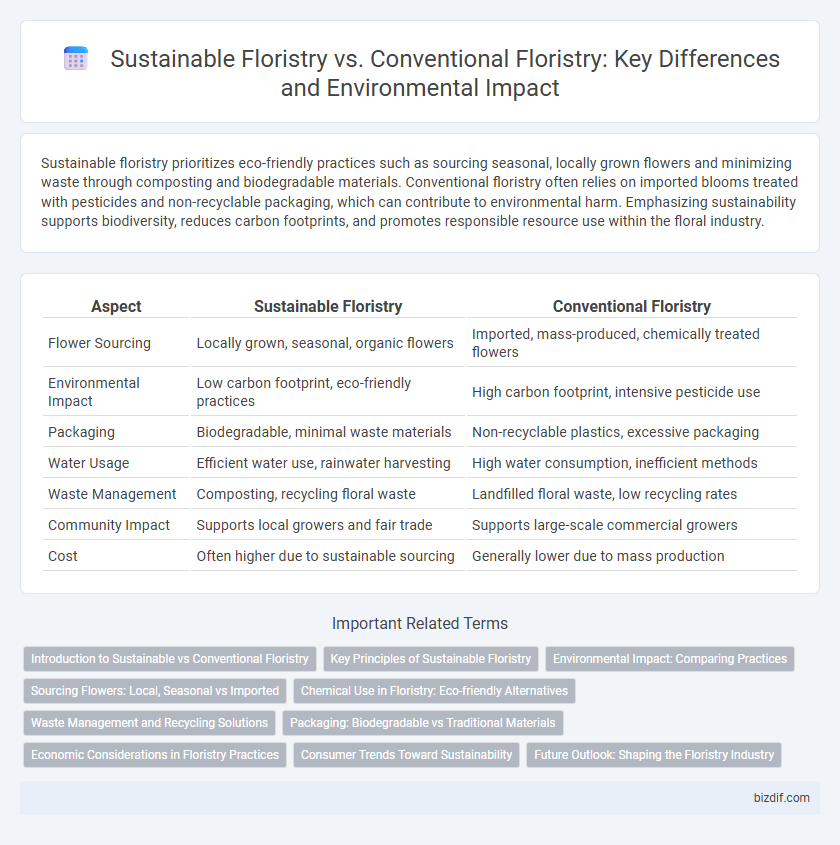Sustainable floristry prioritizes eco-friendly practices such as sourcing seasonal, locally grown flowers and minimizing waste through composting and biodegradable materials. Conventional floristry often relies on imported blooms treated with pesticides and non-recyclable packaging, which can contribute to environmental harm. Emphasizing sustainability supports biodiversity, reduces carbon footprints, and promotes responsible resource use within the floral industry.
Table of Comparison
| Aspect | Sustainable Floristry | Conventional Floristry |
|---|---|---|
| Flower Sourcing | Locally grown, seasonal, organic flowers | Imported, mass-produced, chemically treated flowers |
| Environmental Impact | Low carbon footprint, eco-friendly practices | High carbon footprint, intensive pesticide use |
| Packaging | Biodegradable, minimal waste materials | Non-recyclable plastics, excessive packaging |
| Water Usage | Efficient water use, rainwater harvesting | High water consumption, inefficient methods |
| Waste Management | Composting, recycling floral waste | Landfilled floral waste, low recycling rates |
| Community Impact | Supports local growers and fair trade | Supports large-scale commercial growers |
| Cost | Often higher due to sustainable sourcing | Generally lower due to mass production |
Introduction to Sustainable vs Conventional Floristry
Sustainable floristry emphasizes eco-friendly practices by using locally sourced, seasonal flowers and biodegradable materials to reduce environmental impact. Conventional floristry often relies on imported flowers, synthetic chemicals, and non-recyclable materials, contributing to higher carbon footprints and waste generation. The contrast highlights the growing consumer demand for environmentally responsible floral designs and the shift towards greener industry standards.
Key Principles of Sustainable Floristry
Sustainable floristry emphasizes the use of locally sourced, seasonal flowers to reduce carbon emissions and support biodiversity, contrasting with the conventional floristry reliance on imported, out-of-season blooms. Key principles include minimizing waste through composting and eco-friendly packaging, promoting fair labor practices, and prioritizing native plant species to preserve ecosystems. This approach integrates environmental responsibility with artistic expression, fostering a greener floral industry.
Environmental Impact: Comparing Practices
Sustainable floristry minimizes environmental impact through the use of locally sourced, seasonal flowers and biodegradable materials, reducing carbon footprints and waste. Conventional floristry often relies on imported flowers grown with heavy pesticide use and non-recyclable packaging, leading to higher energy consumption and pollution. Emphasizing sustainable practices supports biodiversity and conserves natural resources while conventional methods contribute significantly to habitat destruction and greenhouse gas emissions.
Sourcing Flowers: Local, Seasonal vs Imported
Sustainable floristry prioritizes sourcing flowers locally and seasonally to reduce carbon emissions and support regional ecosystems, while conventional floristry often relies on imported blooms that require extensive transportation and chemical preservation. Local and seasonal flowers tend to be fresher, longer-lasting, and cultivated using environmentally friendly practices, aligning with eco-conscious consumer demands. Imported flowers typically undergo intensive farming methods and long-distance shipping, contributing to higher environmental footprints and less sustainable supply chains.
Chemical Use in Floristry: Eco-friendly Alternatives
Sustainable floristry minimizes chemical use by adopting eco-friendly alternatives such as organic fertilizers, natural pest control methods, and biodegradable floral foam, reducing environmental impact compared to conventional floristry. Conventional floristry relies heavily on synthetic pesticides, chemical preservatives, and non-biodegradable materials that contribute to soil and water pollution. Choosing sustainable practices enhances plant health, supports biodiversity, and promotes a safer environment for florists and consumers alike.
Waste Management and Recycling Solutions
Sustainable floristry prioritizes waste management by implementing composting techniques and using biodegradable materials to minimize landfill contributions, contrasting sharply with conventional floristry, which often relies on single-use plastics and non-recyclable floral foam. Recycling solutions in sustainable practices include repurposing plant trimmings and organic waste into nutrient-rich compost, supporting circular resource use within the floristry industry. These eco-friendly methods significantly reduce environmental impact by lowering carbon footprints and promoting responsible resource consumption throughout the flower arrangement lifecycle.
Packaging: Biodegradable vs Traditional Materials
Sustainable floristry employs biodegradable packaging made from materials like recycled paper, cornstarch, or plant fibers, significantly reducing environmental impact. In contrast, conventional floristry typically relies on traditional plastic films and foam wraps that contribute to non-biodegradable waste and landfill accumulation. Adopting eco-friendly packaging aligns with green practices and appeals to environmentally conscious consumers seeking sustainable floral products.
Economic Considerations in Floristry Practices
Sustainable floristry often reduces costs by prioritizing locally sourced, seasonal flowers that minimize transportation expenses and carbon footprint, enhancing economic viability. Conventional floristry relies heavily on imported or out-of-season blooms, incurring higher costs due to refrigeration, packaging, and long-distance shipping. Choosing sustainable practices can boost profitability by aligning with consumer demand for environmentally responsible products while lowering operational expenditures.
Consumer Trends Toward Sustainability
Consumer trends increasingly favor sustainable floristry as eco-conscious buyers demand ethically sourced, locally grown flowers that reduce carbon footprints and minimize chemical use. Sustainable floristry emphasizes biodegradable materials, water conservation, and fair labor practices, contrasting with conventional floristry's reliance on imported flowers, synthetic pesticides, and plastic packaging. Growing awareness of environmental impact drives a shift toward greener floral designs and certifications like Fair Trade and Rainforest Alliance, reflecting a significant market transformation.
Future Outlook: Shaping the Floristry Industry
Sustainable floristry emphasizes eco-friendly practices such as using locally sourced flowers, biodegradable materials, and reducing waste, driving innovation in floral design and supply chain management. Conventional floristry, reliant on long-distance imports and synthetic inputs, faces increasing scrutiny due to environmental concerns and shifting consumer preferences. The future outlook suggests a strong industry shift toward sustainability as climate impact awareness grows, fostering resilience and new market opportunities for florists committed to green practices.
Sustainable floristry vs Conventional floristry Infographic

 bizdif.com
bizdif.com